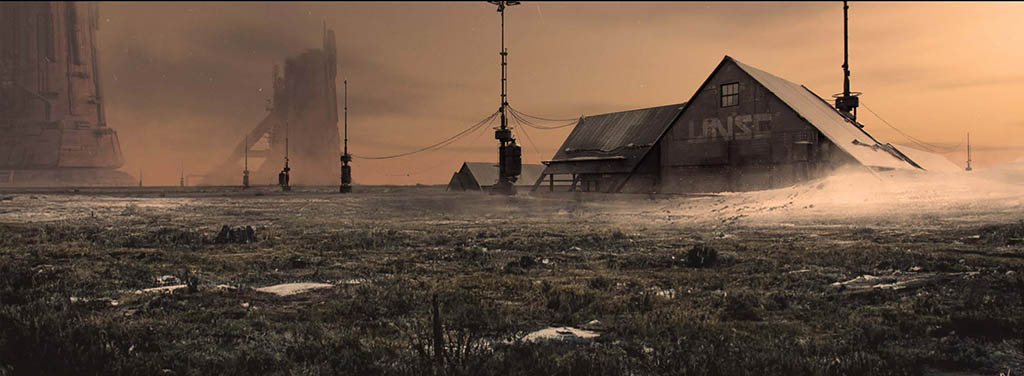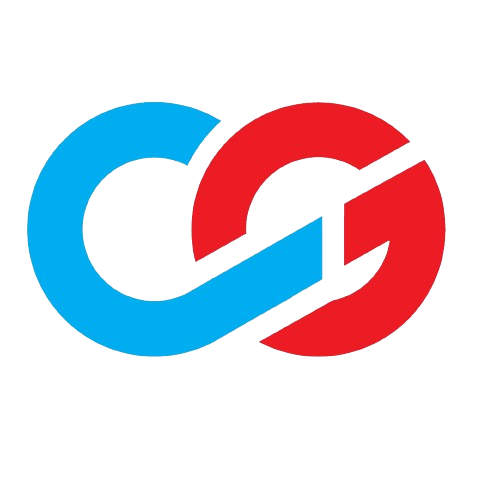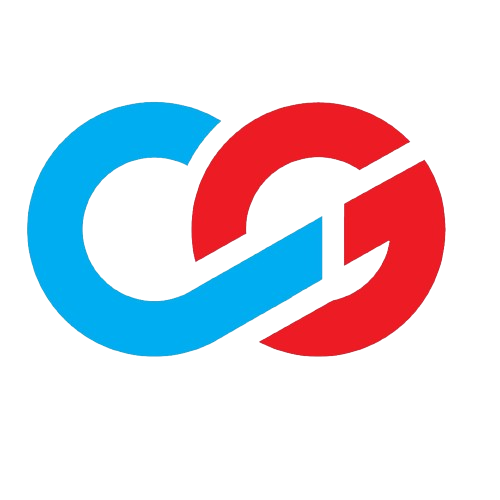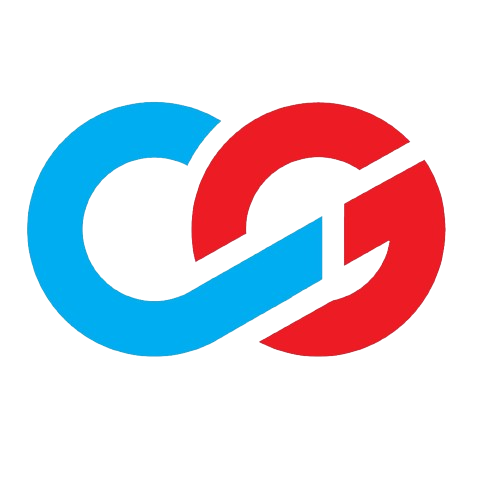
TONAL SHIFT BRINGS A MORE CINEMATIC LOOK TO HALO SEASON 2
www.vfxvoice.com
By TREVOR HOGGImages courtesy of Paramount+There is an influx of video game adaptations, with Paramount+ entering into the fray with the second season of Halo, where the United Nations Space Command battles an alliance of alien races determined to eliminate the human race known as the Covenant. Joining the military sci-fi series, based on the first-person shooter developed by Bungie Studios and 343 Industries, is Showrunner David Wiener, who provided a different narrative focus for the eight episodes.Concept art of Aleria, which is an impoverished Outer Colony located in the Elduros System.You would not believe how much attention was paid to the color of the visors. It poses many challenges. For starters, visors are reflective, so every close-up for us means painting out the camera crew. But at the same time, with the tint and coating that the visors got, quite often the actors couldnt wear the helmets with the visors on. later on in post we had to add them.Wojciech Zielinski, Visual Effects SupervisorAn iconic visual element is the gold-colored visor worn by the UNSC Marine Corps led by the Master Chief. You would not believe how much attention was paid to the color of the visors, states Visual Effects Supervisor Wojciech Zielinski. It poses many challenges. For starters, visors are reflective, so every close-up for us means painting out the camera crew. At the same time, with the tint and coating that the visors got, quite often the actors couldnt wear the helmets with the visors on. They are performing in different environments and lighting conditions, and quite often for safety the visors had to be removed; later on in post we had to add them.Concept art of the landing bay at Camp Currahee, which became an entirely CG build.A side view of a Corvette.The Flood Seed is teased at the end of Season 2.The Light Bridge located at Forerunner City.Atmospherics such as smoke and mist play a heavy role in battle sequences, which means that there has to be tight relationship between stunts, special effects and visual effects. A big proponent of the show is having practical elements as much as possible; however, there is a fine line, Zielinski notes. We always have to figure out what is the right level for the visual effects. We prefer to add more atmosphere or smoke in post. I like to have a base level that we match into; it was quite an organic process. It is tricky to maintain the same level throughout the shots, so later on we had to make sure that the level was consistent in post. The density of smoke heightened the dramatic tension. Quite often, our goal was to have the Jackals [a grouping of the Kig-Yar race] covered in smoke to add more character and something lurking in the smoke. Sometimes, the story literally calls for just a silhouette, but still we believe that the audience will understand, see and read the intention from the storyline. The Jackals make use of lethal energy shields. The shields almost look the same as the ones from Season 1. This is something that we didnt want to play with in Season 2. The look of the shields is close to what they look like in the game. We want to make sure that the gamers appreciate how much has been retained from the game, Zielinski remarks.Conceptualizing the look of a Sanctuary village.A big proponent of show is having practical elements as much as possible; however, there is a fine line. We always have to figure out what is the right level for the visual effects. We prefer to add more atmosphere or smoke in post. I like to have a base level that we match into; it was quite an organic process. It is tricky to maintain the same level throughout the shots, so later on we had to make sure that the level was consistent in post.Wojciech Zielinski, Visual Effects SupervisorSeason 2 commences six months after the narrative of Season 1. You wouldnt see that much of a technological change; however, because of the approach of new Showrunner David Wiener, Season 2 had a slight tonal shift, Zielinski notes. The story is more grounded and centered around the characters. You want to make sure that all of the assets that we inherited from Season 1 will work with what David wanted to achieve. Therefore, we did play with the look development of the creatures. Along with the Jackals are the parasitic alien lifeforms known as the Flood. It is a tease because this is a big character in the game, but literally towards the end of Season 2 we are introducing the Flood, which will hopefully be further developed in Season 3. Its like a fungus that takes over your body and transforms into a combat form. We sourced the design of the Flood from the game, then modified it a little bit to make it feel more alien and organic, Zielinski describes.A key visual element are the virtual companions.The undercity of Reach City, which becomes the target of a Covenant attack.Significantly involved with the production of Halo is Microsoft under the leadership of Kiki Wolfkill, who serves as an Executive Producer, and 343 Industries, which provided game references. In general, all of the environments and creatures were either conceptualized by the Production Designer [James Foster] or the visual effects team, Zielinski states. Because of the new tonal style of the show, were trying to employ a more cinematic look. It is important that every time were with the actors, certain modern and dynamic camera moves that are in the games never end up being utilized because they dont fit the aesthetic of the show. A look book was created by the art department. For every visual effect, we created our own concept art as well. In addition, all of those dynamic sequences were previs, and creature battles were rehearsed by the stunt team and directors before we got even to the camera. Fight choreography was assisted by stuntvis. Its a collaboration between the director, stunt coordinator, whoever at the same time was the second unit director, and visual effects department. There are so many moving pieces, but it all starts with the story. Its a heavy collaboration within a limited time, Zielinski states.A different approach was utilized for Cortana, which relied upon plate photography to get the desired interaction and effect.The [Jackals lethal energy] shields almost look the same as the ones from Season 1. This is something that we didnt want to play with in Season 2. The look of the shields is close to what they look like in the game. We want to make sure that the gamers appreciate how much has been retained from the game.Wojciech Zielinski, Visual Effects SupervisorMore than 2,600 visual effects shots were created over a period of 14 months for the eight episodes. We used some of the vendors working on Season 1, but at the same time we had to find a few others with a skillset that works well for the requirements of the sequence, Zielinski observes. Ultimately, we had 18 vendors, and that kept us busy! The heavy lifters were Luma Pictures, El Ranchito, Monkey Rave, Image Engine, Cbica VFX and Rocket Science VFX. We had a few sequences where we had shared shots, which required a big coordination between the different vendors. Episode 204, which has the Battle of the Reach, is the most action-packed. We follow our heroes battling the Covenant forces attacking Reach City and trying to join the UNSC troops. What is interesting about the sequence are the so-called oners. We had multiple shots that are seamlessly stitched. Those had to be well-rehearsed and prepared to make sure that all of the stitches are working well. Sometimes, the story requires a complex stitch, meaning that we have to make sure that the end of one take is matching as close as possible to the beginning of the other take. It literally took us multiple takes to find the right stitch points.An iconic element are the golden visors that at times had to be replaced digitally.Atmospherics had an important role in making the Jackals even more menacing adversaries during the fight sequences.An effort was made to have partial sets built so that the actors could get the proper environmental interaction.Part of the responsibility of the visual effects team was designing and executing the holographic UI for the spacecrafts.World-building consisted of hybrid and entirely CG environments with 75% of Aleria being a practical set while Camp Currahee was fully digital. The Sanctuary sequence was shot in Iceland on a bluescreen stage, Zielinski explains. Were trying to source as much from the Iceland location and capture as much data as well, knowing later on in post we will be building or augmenting that environment. As far as the Reach City goes, we created CG assets for all of the establishing shots. The asset had to be rebuilt from the ground up to accommodate the destruction of the city in Season 2. It all comes down to overplanning the design of the sequences so we actually know which part of the city will be destroyed and by what means; that makes our life much easier in post and ensures that we focus on the right parts of the asset.A significant number of digital doubles had to be produced. It was quite heavy for digital doubles, especially in the action moments in which we see the Spartans [mechanically and biologically-enhanced elite soldiers] moving fast, Zielinski reveals. It was quite difficult for the actors and stunt team to perform those actions in those heavy suits. Quite often, when you see Spartans running, jumping and climbing mountains, those are digital doubles. With the crowd duplication, we cant always afford having 3,000 extras, so you design the scene or shot with a limited number of extras. You place them close to the camera then populate either the midground or background to set the right number for the shot.More than 2,600 visual effects shots were created by 18 vendors over a period of 14 months for the eight episodes of Season 2.[The Flood] is a big character in the game, but literally towards the end of Season 2 we are introducing the Flood, which will hopefully be further developed in Season 3. Its like a fungus that takes over your body and transforms into a combat form. We sourced the design of the Flood from the game, then modified it a little bit to make it feel more alien and organic.Wojciech Zielinski, Visual Effects SupervisorThen there were the virtual companions. The virtual companion employed the same technology as we did this season for Cortana, Zielinski states. We decided to change the approach from Season 1. In Season 1 Cortana was a full CG character. This time, we applied a hybrid approach; in our case, the character was based on plate photography. We shot an actress interacting or performing with other actors. From the plate, we used the face of the actress, then augmented that with a digital body and CG hair. For Cortana shots, we also built a special LED rig, which was integrated into her practical costume that gave us reactive light on the actor, other actors and the sets.Given the limited number of extras, digital crowd replication was critical in getting the necessary size and scope for shots.The mandate was to go for a more grounded tone for the series.Skies play a pivotal role in establishing the proper visual aesthetic for shots.Bluescreen stages were mixed with real locations to create the various environments required for Season 2 of Halo.There were times when full CG shots were required.A staple of sci-fi are space battles. It was quite exciting for all of us, Zielinski acknowledges. We were happy to finally see some space action. As you can imagine, space battles and space jumps are 99% a full CG creation. For the space battles, we had to redesign all of the fleets of the UNSC and Covenant forces. It has been quite a long process to figure out the choreography and geography of the space battles. On the screen it may seem straightforward, but actually its quite complex. I wanted to make sure that the audience is not disorientated and understands the flow of the story in those shots.
0 Σχόλια
·0 Μοιράστηκε
·365 Views


